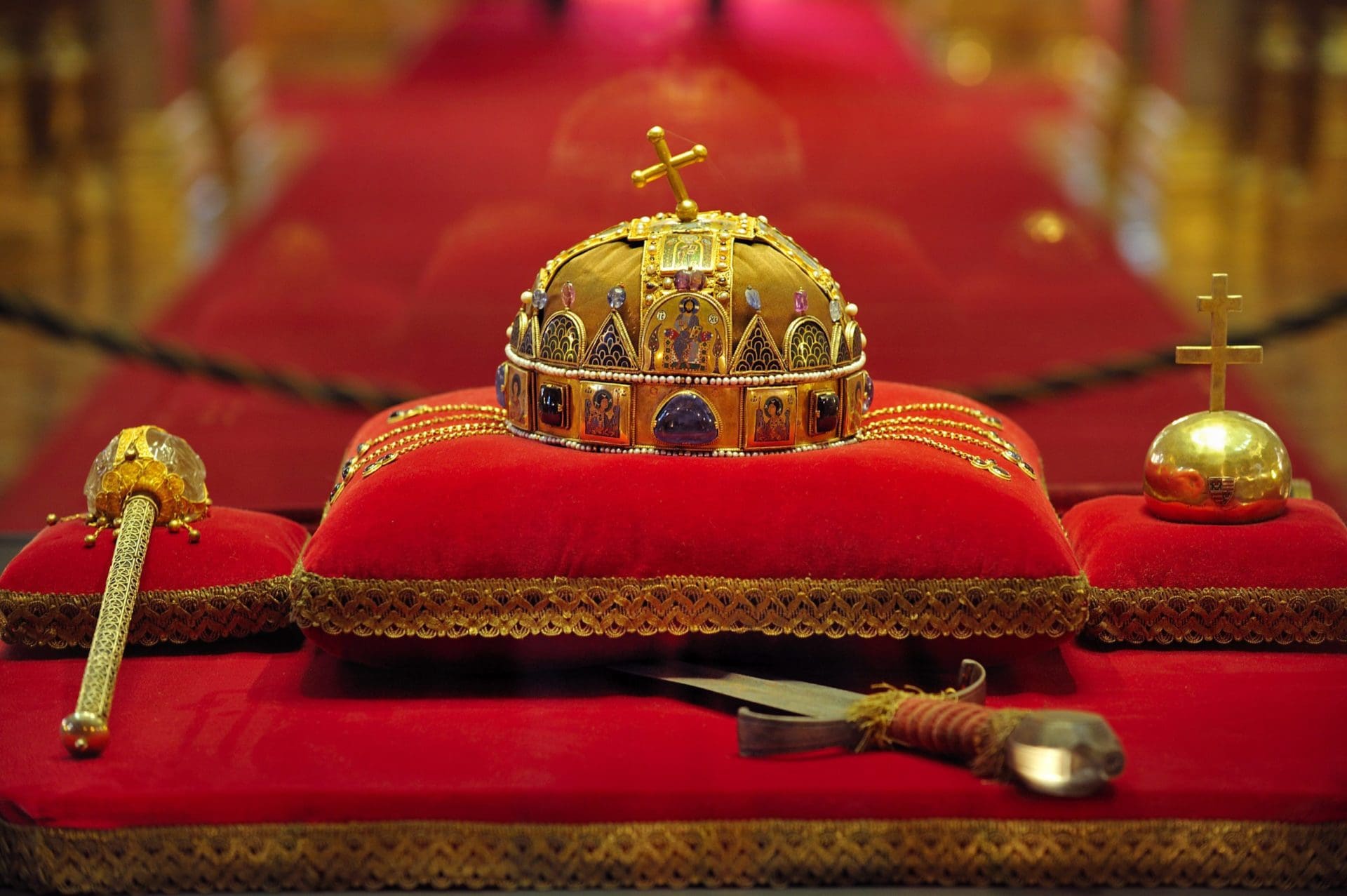According to legends the Holy Crown of Hungary was given to St Stephen (the first king of Hungary, 1000 or 1001–1038) in 1000 from Pope Sylvester II, who was instructed in a dream to gift the Crown to Hungary. Historic research does not seem to support this legend, however. A more likely scenario is that the two parts of the Crown were assembled about two centuries later under the reign of Béla the III of Hungary (1172-1196). The upper part is the Corona Latina (‘Latin Crown’), which is likely to be made from St Stephen’s herm (i.e., head-reliquary).[1] The bottom part is called the Corona Graeca, that is the ‘Greek Crown’ which is likely to be made out of the crown of Géza I’s (1074-1077) wife. The upper part is decorated with Latin while the bottom part is decorated with Greek texts. The icons on the Crown picture eight apostles, Christ, and Byzantine Emperors.
At one point in history the cross on the top of the crown was damaged. Tales hold that during a strife for the Hungarian throne one of the candidates for the throne stole the Crown and wanted to smuggle it out of the country. However, on his way Otto I, Duke of Swabia and Bavaria dropped the Crown damaging its top. Legends aside, a more likely cause of the damage is that the iron chest in which the Crown was stored in much of his life was closed rather uncarefully, hitting, and hence damaging the cross. The cross is in a position slanted to the left, and the golden plate underneath is crooked. This damage was never repaired; the position of the cross became part of how the cross is traditionally depicted.
The Doctrine holds that Hungary is of the Holy Crown, everything that Hungary is, belongs to the Crown himself
Connected to the Holy Crown, there is a doctrine which speaks of the significance of the Crown to Hungary. According to the Doctrine of the Holy Crown, the Crown itself has a personhood that is identical to Hungary. The Doctrine holds that Hungary is of the Holy Crown, everything that Hungary is, belongs to the Crown himself. The ruler only rules in the name of the Crown, but he is subordinate to its will—that which is the will o Hungarians. According to the tradition, the Crown is holy because St Stephen (first king of Hungary, 1000 or 1001–1038) sealed a divine contract with the Virgin Mary, offering the country to her, and gaining divine legitimacy for future Hungarian kings to rule the country. The Doctrine thus signifies that the one wearing the Crown rules by divine right. The Doctrine also allows for the right to resist, however, if the king breaks his coronation oath and becomes tyrannical, the nobility can resist the tyrannical king to protect the Holy Crown.[2]
To be crowned as a legitimate Hungarian king the coronation necessarily had to happen with the Holy Crown by the Cardinal of Esztergom in Székesfehérvár. Later, when the Ottoman Empire took over Székesfehérvár, Pozsony (Pressburg, today Bratislava) became the coronation city (between 1563 and 1830). Later coronations were moved to Buda—the site of the last Hungarian coronation, in 1916. Not only kings but Hungarian queens were also coronated with the Holy Crown. However, while kings wore the Crown for the duration of the celebration, queens did not wear the symbol on their heads—their right shoulder was touched by the Crown instead to symbolise that the sovereign can rely on the queen whose duty is to assist the king in justly ruling the country.[3]
The one thousand years the Crown lived through was not always without difficulties. After the defeat of the 1848-49 Revolution and Freedom Fight—to prevent the Crown going into the hands of the Habsburgs—the iron chest with the Crown and all the other coronation symbols in it was buried underground. It was only in 1853 that due to the treachery of István Wargha the crown was discovered and brought up to light again, just to be taken out of the country by the Habsburgs. Shortly after World War II in 1945, the Crown was buried again in Mattsee. It was found by American soldiers and taken to a military base in Kentucky. The period between 1945 and 1978 when the Crown was given back to Hungary is one of the longest periods the Holy Crown ever spent beyond the border of Hungary. In 1978 Jimmy Carter gave back the Crown symbolically not to János Kádár (the then dictator of Hungary) but to the ‘Hungarian people’—Kádár was disadvised from attending the ceremony on the return of the Crown.
In 1978 Jimmy Carter gave back the Crown symbolically not to János Kádár (the then dictator of Hungary) but to the ‘Hungarian people’
In 1990 the Hungarian state denied the request to temporarily exhibit the Crown in the USA, arguing that the Holy Crown shall never again leave the territories of Hungary. The Crown is one of the most important Hungarian national symbols, which embodies Hungary’s sovereignty, therefore its place is in Hungary. Today the Crown is kept and exhibited in the centre of the Hungarian Parliament.
[1] Máté Mezei, ‘A magyar Szent Korona története’, Újszó (20 August 2019); https://ujszo.com/panorama/a-magyar-szent-korona-tortenete, accessed 25 June 2022.
[2] That’s Life, ‘A Szent Korona története’, That’s Life (18 July 2017); https://thatslife.hu/apropo/20210718-a-szent-korona-tortenete.html, accessed 25 June 2022.
[3] Múlt-Kor, ’10 tény a Szent Koronáról’, Múlt-kor ( 9 Sept. 2022); https://mult-kor.hu/10-teny-a-szent-koronarol-20200909, accessed 25 June 2022.








